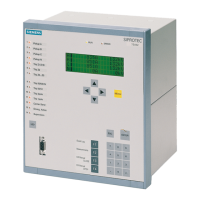Section 2.2 for more information). When utilizing the dropout time delay, it is recommended to set it to a
shorter time than the OFF-command time delay in order to avoid both times to "race".
The dropout ratio of the function can be selected in parameter DROPOUT RATIO. The standard dropout ratio
of protection functions is 0.95 (default setting). If the function is used as power protection, a dropout ratio of
at least 0.9 should be set. The same applies to the utilization of the symmetrical components of current and
voltage. If the dropout ratio is decreased, it would be sensible to test the pickup of the function regarding
possible "chatter".
The dropout difference of the frequency elements is set under parameter DO differential. Usually, the
default setting of 0.02 Hz can be retained. A higher dropout difference should be set in weak systems with
larger, short-term frequency fluctuations to avoid chattering of the message.
A fixed dropout difference of 0.1 Hz/s is used for the frequency change (df/dt) measurand. The same applies to
the voltage change (dU/dt) measurand. The permanent dropout difference here is 3 V/s.
Parameter BLK.by Vol.Loss determines whether a function whose measured variable is based on a voltage
measurement (measured quantities voltage, P forward, P reverse, Q forward, Q reverse and power factor),
should be blocked in case of a measured voltage failure (set to YES) or not (set to NO).
Renaming Messages, Checking Configurations
After parameterization of a flexible function, the following steps should be noted:
•
Open matrix in DIGSI
•
Rename the neutral message texts in accordance with the application.
•
Check configurations on contacts and in operation and fault buffer, or set them according to the require-
ments.
Further Information
The following instruction should be noted:
•
As the power factor does not differentiate between capacitive and inductive, the sign of the reactive
power may be used with CFC-help as an additional criterion.
Settings
Addresses which have an appended “A” can only be changed with DIGSI, under “Additional Settings”.
The table indicates region-specific default settings. Column C (configuration) indicates the corresponding
secondary nominal current of the current transformer.
Addr.
Parameter C Setting Options Default Setting Comments
0 FLEXIBLE FUNC. OFF
ON
Alarm Only
OFF Flexible Function
0 OPERRAT. MODE 3-phase
1-phase
no reference
3-phase Mode of Operation
0 BLK f out of r YES
NO
YES Block while Freq. is out of
range
2.18.3
Functions
2.18 Flexible Protection Functions
250 SIPROTEC 4, 7SJ80, Manual
E50417-G1140-C343-A8, Edition 12.2017
